
94% of researchers rate our articles as excellent or good
Learn more about the work of our research integrity team to safeguard the quality of each article we publish.
Find out more
ORIGINAL RESEARCH article
Front. Environ. Sci., 16 November 2020
Sec. Freshwater Science
Volume 8 - 2020 | https://doi.org/10.3389/fenvs.2020.577748
This article is part of the Research TopicBalancing Hydropower and Freshwater Environments in the Global SouthView all 13 articles
 Ibraim Fantin-Cruz1*
Ibraim Fantin-Cruz1* Marcia Divina de Oliveira2
Marcia Divina de Oliveira2 Juliana Andrade Campos3
Juliana Andrade Campos3 Marcel Medinas de Campos1
Marcel Medinas de Campos1 Letícia de Souza Ribeiro1
Letícia de Souza Ribeiro1 Rafael Mingoti4
Rafael Mingoti4 Marcelo Luiz de Souza5
Marcelo Luiz de Souza5 Olavo Pedrollo3
Olavo Pedrollo3 Stephen K. Hamilton6,7*
Stephen K. Hamilton6,7*Small hydropower (SHP) facilities, which are defined by installed capacities <10–50 MW, are increasingly being built around the world. SHPs are viewed as less environmentally harmful than larger dams, although there has been little research to support that assertion. Numerous SHPs have been built, and many more are in development or proposed, in rivers that drain into the Pantanal, a world-renowned floodplain wetland. Three river systems with the largest contributions of sediments to the Pantanal—the Cuiabá, upper Taquari, and Coxim rivers—remain largely undammed. The upland tributaries transport sediments into the Pantanal, thereby affecting geomorphological dynamics and biological productivity of downstream floodplains. This study presents measurements from upstream and downstream of current hydropower facilities, most of which are SHPs, throughout the upland watersheds of the Upper Paraguay River basin to reveal how these facilities may affect the transport of suspended sediments and of bedload sediments. In addition, a predictive model using artificial neural networks (ANNs) estimates the impact of building 80 future SHPs on sediment transport based on observations at current facilities as well as the spatial distribution of future facilities. More than half of current facilities retained suspended sediments: 14 of the 29 facilities showed >20% net retention of suspended sediments, two others retained between 10 and 20%, seven were within 10%, and six showed >10% net release. Bedload sediment transport was a small component of total sediment transport in rivers with high total sediment loads. Multiyear series of satellite images confirm sediment accumulation in several cases. Model predictions of the impacts of future hydropower facilities on suspended sediment concentrations and transport show retention of a large fraction (often much >20%) of sediment inputs. Summing riverine transport rates for inflows into the Pantanal indicates that currently envisioned future hydropower development would reduce the suspended sediment transport by ∼62% from the current rate. This study shows that if SHPs are built on sediment-rich rivers, this may prove problematic for the facilities as well as for downstream ecosystems. These results support recommendations that several river systems presently lacking dams in their lower reaches should be excluded from future hydropower development to maintain the sediment supply to the Pantanal.
One of the most important effects of the construction of dams on rivers is the retention (trapping) of sediment (Syvitski et al., 2005). Conventional storage dams with reservoirs that are large relative to the river channel (i.e., high reservoir capacity to inflow ratios) often have sediment trapping efficiencies exceeding 90% when newly constructed (e.g., Kondolf et al., 2014b), though the efficiency may decline over time if sediment infilling reduces reservoir capacity. As reservoir capacity decreases relative to inflow discharge, sediment trapping will decline and ultimately reach a point where it is negligible because flow and turbulence maintain sediment transport through the reservoir. Toward that end of the continuum, the design of the hydropower facility, the particle size distribution of transported sediments, and the seasonal patterns of discharge and sediment transport become important variables, although relatively few studies have considered the effects of smaller dams on sediment transport (Csiki and Rhoads, 2010).
The possible retention of sediments by small hydropower (SHP) facilities is important to understand because most hydroelectric dams being built around the world today are SHPs. Given their small size, they would seem to be less environmentally harmful than larger dams, but the effects of modern SHP designs on riverine transport of sediments have seldom been investigated, and almost no research exists outside of developed regions in the North America and Europe (Mbaka and Mwaniki, 2015; Couto and Olden, 2018). Despite the paucity of information, many countries have enacted policies that promote SHPs, including minimal environmental review. Where multiple SHPs are or will be located in series along river systems, their cumulative effects on sediment transport to downstream ecosystems deserve attention (Kibler and Tullos, 2013; Athayde et al., 2019).
The Amazon, Paraná, and Paraguay river watersheds of South America have a large number of existing and proposed SHPs (Couto and Olden, 2018), including in the watershed of the Upper Paraguay River basin in Brazil that drains to the Pantanal floodplains (Figure 1A). The Pantanal, which is internationally recognized as a globally important wetland ecosystem, is a 140,000-km2 complex of coalesced alluvial fans, much of which is subject to seasonal inundation by riverine overflow that commonly lasts for months (Hamilton et al., 1996). The upland tributaries transport sediments into the Pantanal, which affect the geomorphological dynamics of channel and floodplain features, aquatic-terrestrial connectivity, and soil fertility of downstream floodplains. Floodplain lands subject to inundation by sediment-rich river water tend to be more productive (Hamilton, 2002; Junk et al., 2011), and sediment-rich rivers maintain dynamic changes in channel and floodplain geomorphology, which in turn increase floodplain ecosystem diversity (e.g., the Taquari River fan in the Pantanal: Jongman, 2005). In addition to impacts on the transport of sediments and associated nutrients, many species of migratory fishes important to fisheries in the region ascend the upland tributaries to spawn and dams present migration barriers (Campos et al., 2020).
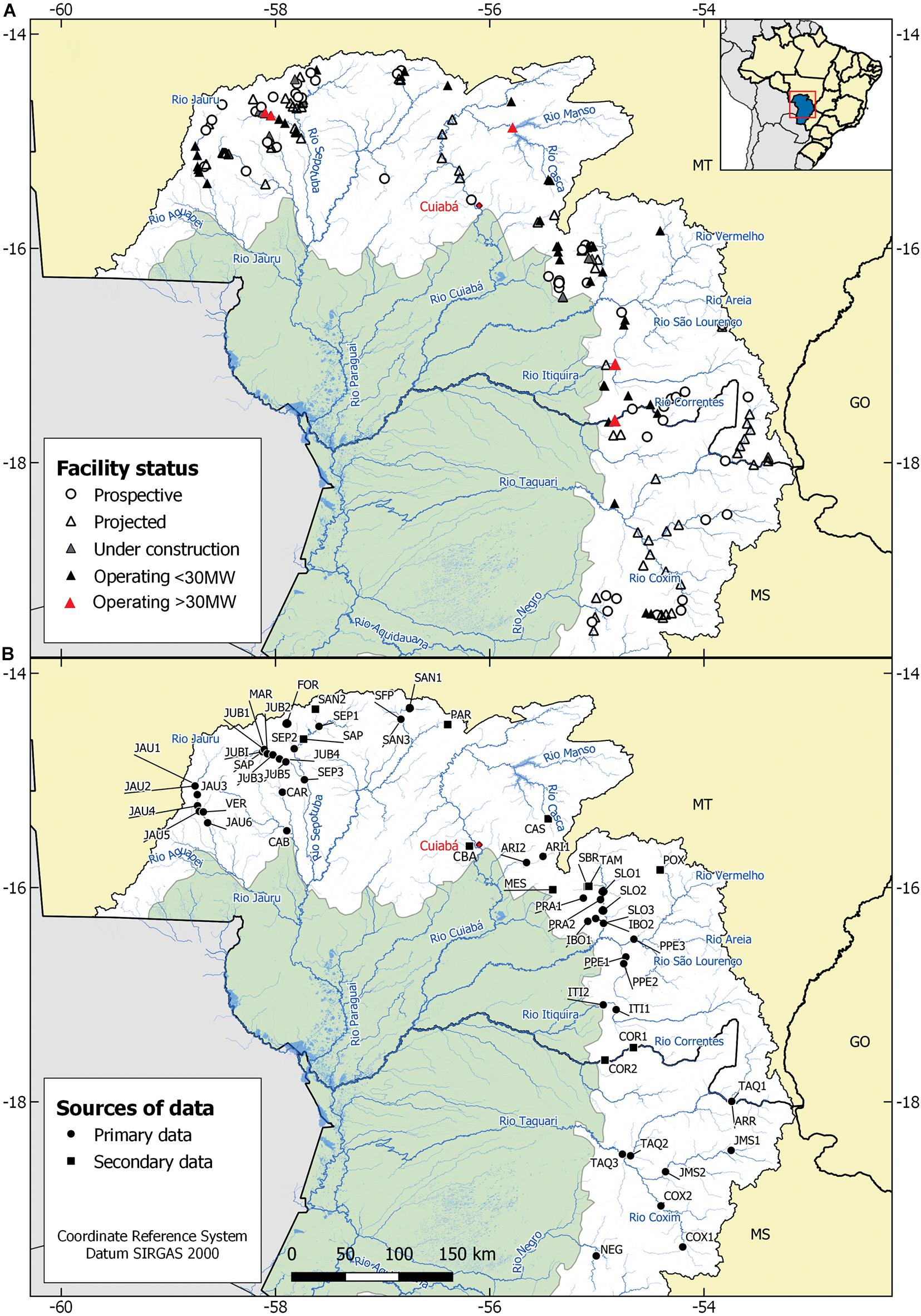
Figure 1. (A) Hydropower facilities in the upland watershed of the Pantanal that are currently in operation as well as future projects that are under construction, planned, or identified as potential sites for hydropower development by either the Brazilian National Electric Energy Agency (ANEEL) or the state environmental agencies (depending on location). Red triangles indicate the four studied facilities with installed capacities >30 MW. (B) Sampling sites for sediment transport, including sampling conducted by the authors (primary data) as well as secondary data derived from environmental compliance reports submitted to state agencies (SEMA-MT and IMASUL) and from previous scientific studies. The Pantanal floodplains are shaded in green and rivers (rios) and other water bodies are shown in blue. Sampling site codes are identified in Table 1.
In the Pantanal watershed, as of 2018 there were 47 hydropower facilities in operation (hereafter “current hydropower facilities”), all but four of which are SHPs, with an additional 138 projects under construction, planned, proposed, or identified by the government as prospective sites (hereafter “future hydropower facilities”) [Agência Nacional de Águas [ANA], 2018; Figure 1A]. Many of the current and future projects are closely situated along river reaches, creating “cascades” where one project begins a short distance below the end of an upstream one.
In light of the ongoing construction and planning of future SHPs in the Pantanal watershed, there is an urgent need to understand how numerous SHPs on the tributaries may, in aggregate, alter the transport of sediments and nutrients from the uplands into the Pantanal. In recognition of these needs, the present study is part of a multidisciplinary research program that has examined many dimensions of the issues surrounding hydroelectric facilities in the tributaries of the Pantanal, including hydrology (Collischonn et al., 2019; Figueiredo et al., in review), sediment transport (this study), nutrient transport (Oliveira et al., in press), and fish and fisheries. Here we present measurements from above and below a number of current hydropower facilities throughout the Pantanal watershed to reveal how these facilities may trap sediments and thereby affect downstream sediment transport to the Pantanal. In addition, we develop a predictive model using artificial neural networks (ANNs) to estimate the impact of future hydropower development on sediment transport into the Pantanal, based on observations at current facilities as well as the distribution of future facilities. A companion paper in this journal (Oliveira et al., in press) presents a complementary examination of how SHPs affect nutrient transport to the Pantanal, including particulate forms associated with sediment transport; the two studies are parts of the same project but are presented separately because of their distinct methodologies and the different ecosystem implications of changes in sediment and nutrient transport. We conclude both papers with recommendations developed from consideration of how both sediment and nutrient transport are impacted by future SHP development.
This study examines rivers in the Brazilian portion of the Upper Paraguay River basin that drain to the Pantanal wetland, which in turn drains to the Paraguay River. The upland watershed (150 to 1,400 m a.s.l.) represents 59% of the basin area and lies mainly within Brazil east and north of the Pantanal. Sloping terrain in much of the uplands favors rapid runoff and high sediment production. The Pantanal floodplains lie between 80 and 150 m a.s.l. The Köppen-Geiger climate classification is tropical savanna, with mean annual precipitation in the uplands ranging from 1,200 to 1,600 mm, with ∼80% of the annual rainfall in the rainy season from October to April (Supplementary Figure S1). The native vegetation in the uplands is Cerrado savanna. Soil erosion has been increased by conversion of extensive areas to cropland (29% of the upland watershed area analyzed in this study) or pasture (22%) (Zeilhofer et al., 2006). Cattle ranching, subsistence and recreational fishing, and ecotourism are major economic activities within the Pantanal, and the floodplains are globally recognized by conservation organizations because they harbor important populations of several endangered mammals and birds (Tomás et al., 2019).
The characteristics of the current hydropower facilities studied here, as well as the river reaches in which they occur, are given in Supplementary Table S1. All but six of these facilities are SHPs, with installed capacities <30 MW. Three exceed 100 MW. However, installed capacity is not always directly related to the degree to which the passage of river water is slowed, and thus to potential effects of these facilities on sediment transport. For example, two of the facilities that exceed 30 MW (Juba I and II, each 42 MW) have dams and reservoirs similar in size to the SHPs, and one of the SHPs (São Lourenço, 29 MW) creates a reservoir comparable in size to larger facilities such as the largest one studied here, Ponte de Pedra (176 MW). Therefore, we analyze the SHPs and larger facilities together in this study.
Many of the SHPs are located on lower-order rivers with low elevational gradients, and most are diversion designs, where a low dam with a small or non-existent reservoir diverts most of the river discharge into an artificial channel (headrace) that carries the water for up to several km to a powerhouse farther down the river valley (Supplementary Table S1), leaving the natural channel with as little as 10% of the discharge until the water is returned below the powerhouse. Most of these facilities are “run-of-river,” meaning that they cannot alter discharge except on short time scales (Csiki and Rhoads, 2010; Kaunda et al., 2012; Figueiredo et al., in review).
Data on discharge and suspended sediment concentrations (SSCs) from upstream and downstream of current SHPs and several larger hydropower facilities, as well as in reaches where such facilities may be built in the future, were obtained from our own sampling and measurements (primary data) as well as from reports submitted by hydropower companies to the state environmental agencies as required for environmental compliance (secondary data). The SSC and discharge measurements conducted for environmental compliance followed the same field and laboratory methods we used, and analyses were conducted only by certified laboratories with appropriate quality assurance protocols. Secondary data were only included for reaches that we did not sample and the two data sources were never combined for a particular reach. Bedload sediment transport was estimated only where we sampled. The distribution of sampling sites with primary or secondary data is shown in Figure 1B, and sampling site codes used in figures are listed in Table 1.
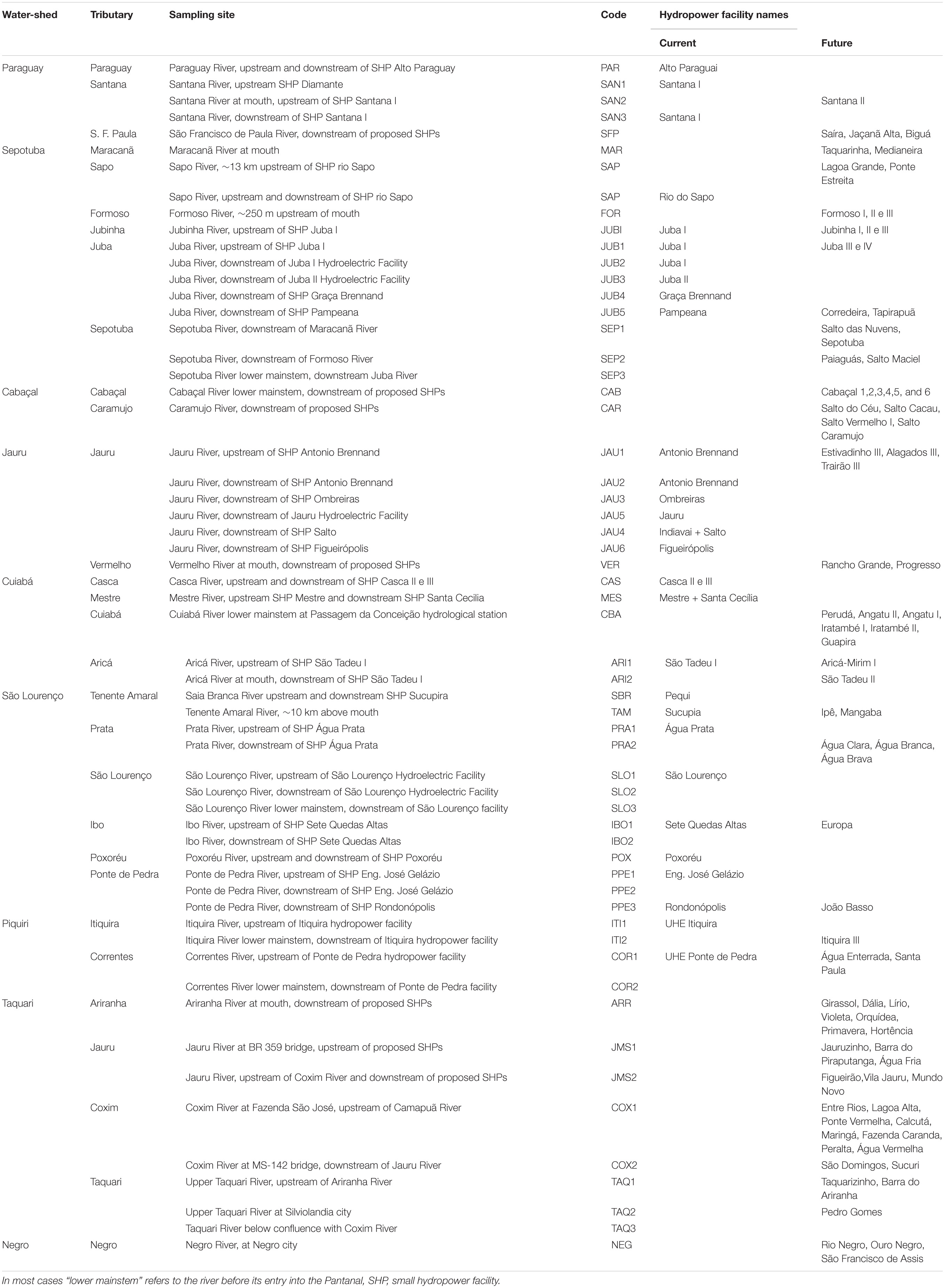
Table 1. List of sampling sites and hydropower facilities they pertain to, with codes for figures and tables.
Primary data on discharge, SSCs, and bedload sediment transport above and below current hydropower facilities were collected on 13 dates spanning the wet and dry seasons from October 2018 to May 2019 (some locations had fewer dates). The primary data set contains data for 17 hydropower facilities. In addition, on 6–13 dates we sampled a number of rivers at locations close to where SHPs may be constructed in the future. More detail on the sampling sites shown in Figure 1 is in Supplementary Table S2.
At each sampling location we recorded the bathymetric profile of the channel cross-section and installed a staff gage unless one already existed there (a number of gages are maintained by hydropower companies). Discharge was measured across the channel profile on each sampling date using an acoustic Doppler current profiler (SonTek RiverSurveyor-M9) following the methods outlined in Agência Nacional de Águas [ANA] (2012). For nine rivers where discharge could not be measured—the Paraguai, Casca, Mestre, Saia Branca, Tenente Amaral, Caeté, Gloria, and Poxoréo rivers—a hydrological model provided estimates (Collischonn et al., 2019).
We collected depth- and flow-integrated water samples by the equal-discharge-increment method. Depth-integrated samples of the water column at each point were obtained with either a DH48 or DH59 integrating sampler depending on hydraulic conditions. Samples from each point were composited in a mixing bucket in volumetric proportion to the discharge contribution of each point, as determined from the profiler data using custom software from the Brazilian National Water Agency [Empresa de Pesquisa Agropecuária e Extensão Rural de Santa Catarina [EPAGRI], 2013]. We analyzed total SSC in water samples gravimetrically after collection of the sediment on filters (0.6 μm pore size). Laboratory analyses of SSC were conducted at Department of Sanitary Engineering at the Federal University of Mato Grosso.
Transported bedload material was collected using a Helley-Smith sampler, and sediment samples from river beds for granulometric analysis were collected using a BMH-60 rotary-bucket bed material sampler (Carvalho, 2008). The Helley-Smith sampler was deployed at three points across the channel. All sediment samples were dried at 105°C for 24 h before weighing. Sediment granulometry was determined using dry sieving (Carvalho, 2008).
The secondary data set contains SSC data for an additional 12 hydropower facilities, including water sampling both before and during their operation. In addition, we incorporated data on rivers not sampled during the present study that were available from the environmental agency of the State of Mato Grosso (SEMA-MT). Out of 980 sediment samplings in the secondary data set, we selected 401 that could be used to analyze the effects of current and future hydropower facilities. Selection criteria included correspondence in timing of the upstream and downstream samplings, and at least five dates of sampling. For cases where more than one location was sampled to represent upstream or downstream water quality, the mean was taken, weighted by the relative discharge in the case of more than one tributary coming together above a facility. Reported values that were below the detection limit of the SSC analyses (1 mg L–1 for primary data and 10 mg L–1 for secondary data) were substituted with the detection limit concentrations.
To estimate the total impacts of all current dams on sediment transport, the impact of the Manso dam in the Cuiabá River system was also considered (Figure 1A). The 212-MW Manso hydropower facility was constructed on the Manso River in the 1990s and creates an extensive reservoir of 427 km2. We analyzed suspended sediment data for the Cuiabá River at the city of Cuiabá, downstream of the Manso River as well as additional tributary inputs that contribute suspended sediments. For the pre-reservoir period, 52 SSC measurements were made by the National Department of Sanitary Works (DNOS) between April 1977 and November 1981 (Barbedo, 2003). For the period after filling the reservoir, 79 SSC measurements were available between September 1999 and October 2016 [station 66260001: Agência Nacional de Águas [ANA], 2020]. These SSC measurements coincided with discharge measurements, allowing comparison of the SSC-discharge relationships.
We assessed the effects of current hydropower facilities on SSCs and transport by comparing the median SSCs upstream and downstream of each facility, based on a combination of primary data (N = 13 dates in most cases) and secondary data (variable numbers of sampling dates). Transport was calculated as the median concentration times discharge, averaging the discharge estimates above and below each SHP location to avoid potential spurious results caused by the uncertainty inherent in discharge measurements as well as by short-term (sub-daily) fluctuations imposed by the hydropower facilities (hydropeaking: Figueiredo et al., in review).
Bedload sediment transport for cross sections represented by each sampling point was calculated from the Helley-Smith samples following Carvalho (2008):
Where,
Qb = total bedload sediment transport (load) in the channel (t d–1);
Eam = hydraulic efficiency of the sampler;
p = dry weight of the sediment sample (kg);
(di+1 − di–1) = channel width of the cross-section represented by the sample (m);
l = width of the sampler opening (m);
t = time sampler was deployed (s).
Observed ratios of upstream to downstream SSCs and transport and bedload sediment transport were grouped into classes based on the percentage change in either direction (i.e., retention or release), similar to the sustainability boundary approach suggested by Richter et al. (2012) for analysis of flow regime alterations in river systems that lack detailed knowledge of the impacts of altered flows. Ratios of <10% were defined as undetectable changes, 10–20% as moderate, and >20% as high alterations.
In addition to comparing the median concentrations and transport rates for all sampling dates combined for each study reach, we conducted statistical analyses of the changes in suspended sediment and bedload transport observed across all individual sampling dates in each reach using a one-sample t-test for which the null hypothesis was zero change. Analyses were conducted after log10 transformation of the concentration changes to improve normality.
Artificial neural networks were developed to predict the impacts of new hydropower facilities on total suspended solid concentrations and bedload sediment transport. As one of the most commonly used artificial intelligence tools, ANNs are well suited to model phenomena subject to controls that are complex, incompletely understood, and likely non-linear [American Society of Civil Engineers [ASCE], 2000]. The ANN model architecture was a three-layer feedforward network with a non-linear (unipolar sigmoid) activation function (Supplementary Figure S2), similar to ANNs that have been applied to study floodplain inundation in the Pantanal (Fantin-Cruz et al., 2011) as well as elsewhere (Dawson et al., 2006).
The ANN models were trained with a data set representing 32 locations (including primary and secondary data). The back-propagative algorithm (Rumelhart et al., 1986), along with training acceleration techniques (Vogl et al., 1988) as well as other needed functions, were custom programmed in the MATLAB R2012b environment. Overfitting was avoided using the cross-validation technique (Hecht-Nielsen, 1989).
For cross-validation training, the data were divided into three samples (53% for training, 26% for validation, and 20% for verification), using a systematic sampling method to provide a representative distribution of the 32 locations for all samples. The extreme values (maximum and minimum) of all variables were included in the training samples and all input data of the future hydropower facilities were within the domain of the trained ANN, ensuring that model predictions were within the ranges of the training data.
The complexity of the ANNs (number of neurons in the intermediate layer) was defined by the architecture search with the lowest possible complexity that still had the same approximation and generalization capacity of a purposely oversized ANN that was trained without overfitting. These approximation and generalization capacities were verified by the performance of the application to the validation sample, since the verification sample, by definition, cannot participate, neither in training nor in the definition of the ANN architecture (Hecht-Nielsen, 1989).
In the present study, input variables that were considered for the ANNs included contributing watershed area, reservoir area and volume, soil classification [11 classes in the contributing watersheds: Empresa Brasileira de Pesquisa Agropecuária [EMBRAPA], 2018], land use and cover [8 classes: Empresa Brasileira de Pesquisa Agropecuária [EMBRAPA], 2015], and upstream concentrations of suspended sediments. Sufficient information was available for 80 of the 138 potential future hydropower facilities.
The potential watershed yields of sediment to river systems were estimated from the Soil and water assessment tool (SWAT), the full results of which are posted online (Mingoti et al., 2020). Details of this SWAT model are presented by Neitsch et al. (2011) and Arnold et al. (2012). The SWAT model was run for each watershed for the year 2017 using spatial data on climate, topography, soils, and land use and cover. Annual and monthly inputs were estimated for the contributing watersheds above each current and future hydropower facility.
The ANN model was trained with measured concentrations of suspended sediments (n = 571 measurements) above and below 34 current hydropower facilities, as well as the contributing watershed area and reservoir area and volume for each facility (Supplementary Table S1). Pearson linear correlations between input and output variables indicated the best predictive variables for each model. Overall performance of the ANNs was evaluated by the Nash-Sutcliffe model efficiency coefficient.
We estimated the total sediment transport to the Pantanal from the most downstream sampling points on each major tributary (Figure 1). In addition, the aggregate impact of current hydropower facilities was estimated by comparing current sediment transport with the total sediment retention by all current facilities, including the Manso dam. These estimates of total sediment transport and retention at present were then compared with the ANN model predictions of the impacts of future hydropower development on sediment transport.
Time series of optical satellite imagery were visually examined for evidence of sediment accumulation in reservoirs among the study sites. Publicly available imagery was obtained from the Landsat 5 Thematic Mapper, Landsat 7 Enhanced Thematic Mapper Plus, Landsat 8 Operational Terra Imager, China–Brazil Earth Resources Satellite 4, and Sentinel 2 satellites. Two cases are presented here as instructive examples—the Itiquira and São Lourenço hydropower reservoirs.
Rivers flowing from the upland watershed into the Pantanal, sampled at points below any hydropower facilities, showed a wide range of SSCs and transport (Figure 2 and Supplementary Tables S3, S4). The sites in Figure 2 are ordered by increasing discharge, which shows that with the exception of the Coxim River (COX2), rivers below the median discharge had relatively low SSCs and transport. Most of the rivers with the highest SSCs and transport are as yet largely undammed (Figure 1A), including the Vermelho, Coxim, upper Taquari, Miranda, and Aquidauana rivers, although the Cuiabá River still carries relatively high SSC loads in spite of a large upstream reservoir (Manso) on one of its principal tributaries (Manso River) that traps nearly all suspended sediment inputs (Carvalho and Lôu, 1990).
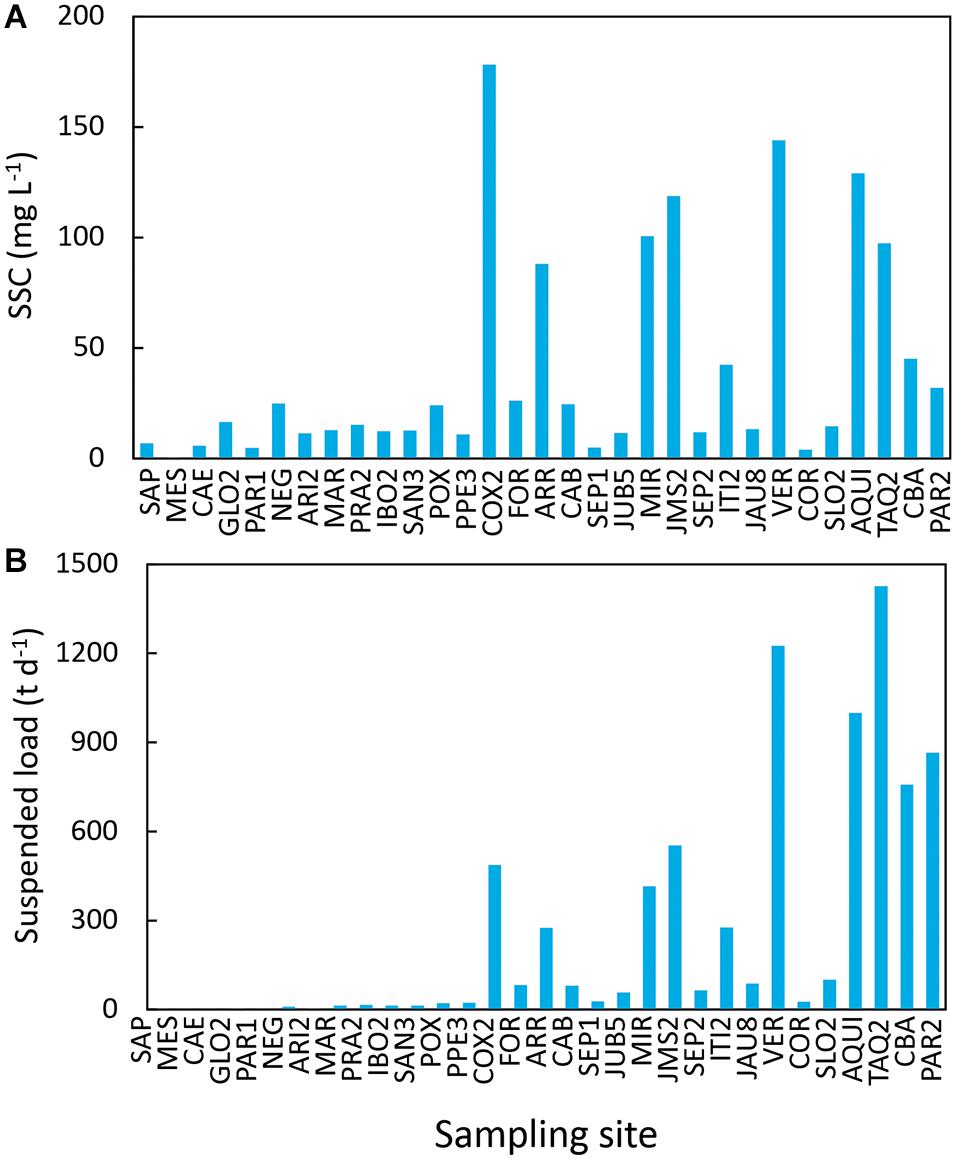
Figure 2. (A) Suspended sediment concentrations (SSC) and (B) loads (transport) in rivers that drain into the Pantanal, for sampling sites below any hydropower facilities. Sites are ordered by increasing discharge and their codes are identified in Table 1.
Bedload sediment transport in rivers flowing from the upland watershed into the Pantanal was small compared to the suspended sediment load in the rivers with high total sediment loads (Figure 3). Bedload comprised the largest percentage of total sediment transport in the Negro and Formoso rivers, which carried low SSCs.
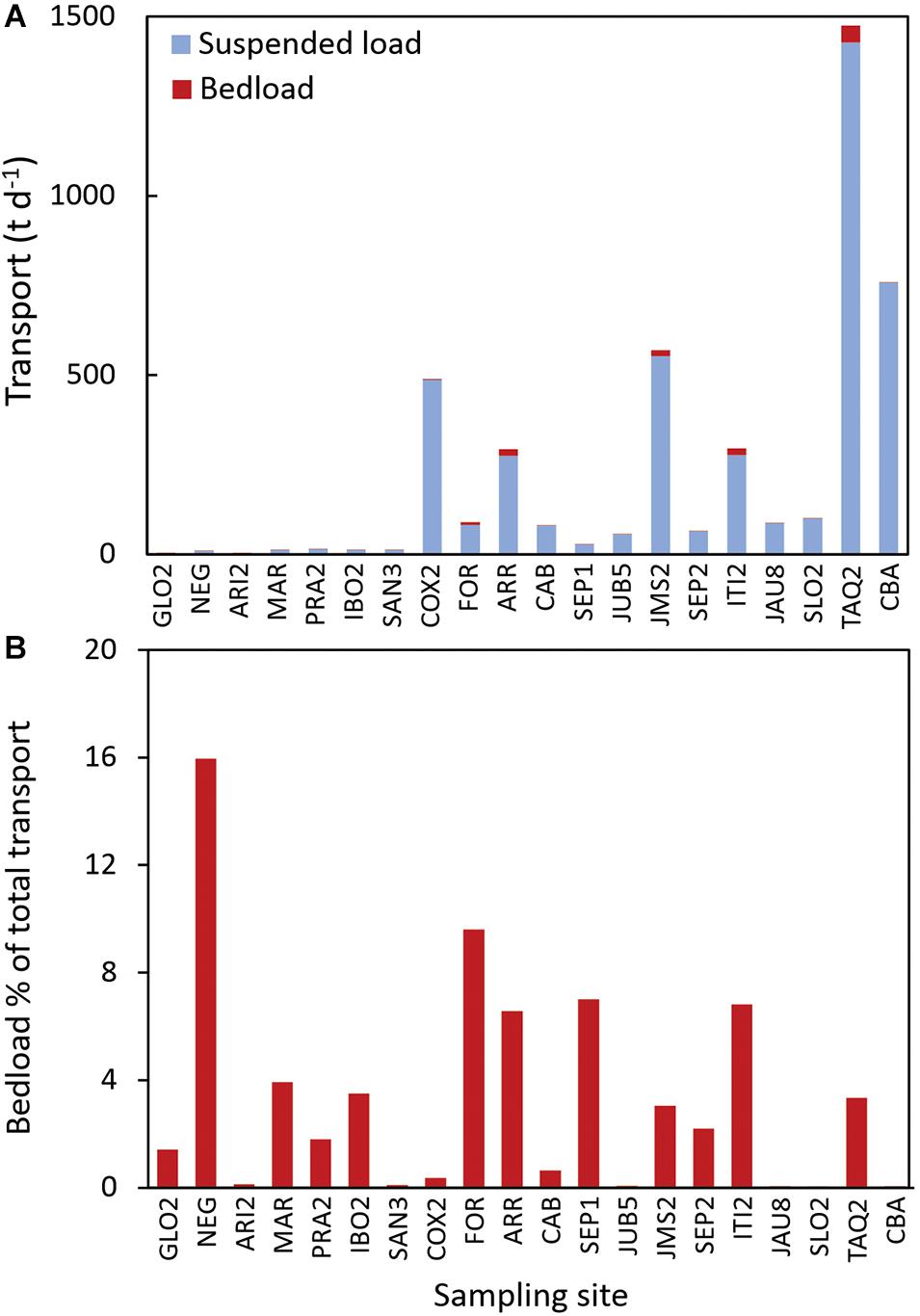
Figure 3. (A) Suspended and bedload sediment transport and (B) bedload as percent of total sediment transport (i.e., bedload plus suspended) in rivers that drain into the Pantanal, for sampling sites below any hydropower facilities. All sites shown here have bedload data but in some cases the bars are too small to be visible in (B). Sites are ordered by increasing discharge and their codes are identified in Table 1.
Concentrations and transport of suspended sediments upstream and downstream of 29 current hydropower facilities are compared in Figure 4 and Supplementary Table S3. The changes between upstream and downstream are presented as both concentrations, which bear on the nutrient availability and aquatic ecology of downstream waters, and rates of transport (i.e., t d–1), which bear on the overall sediment supply from the upland watersheds to the Pantanal. For a given hydropower facility, the ratios between concentrations and transport covary because we assumed that discharge did not change and therefore we used the mean of upstream and downstream discharge measurements to calculate transport. We do not consider bedload here because it was a small proportion of total sediment transport except in some rivers with low total sediment transport (Figure 3).
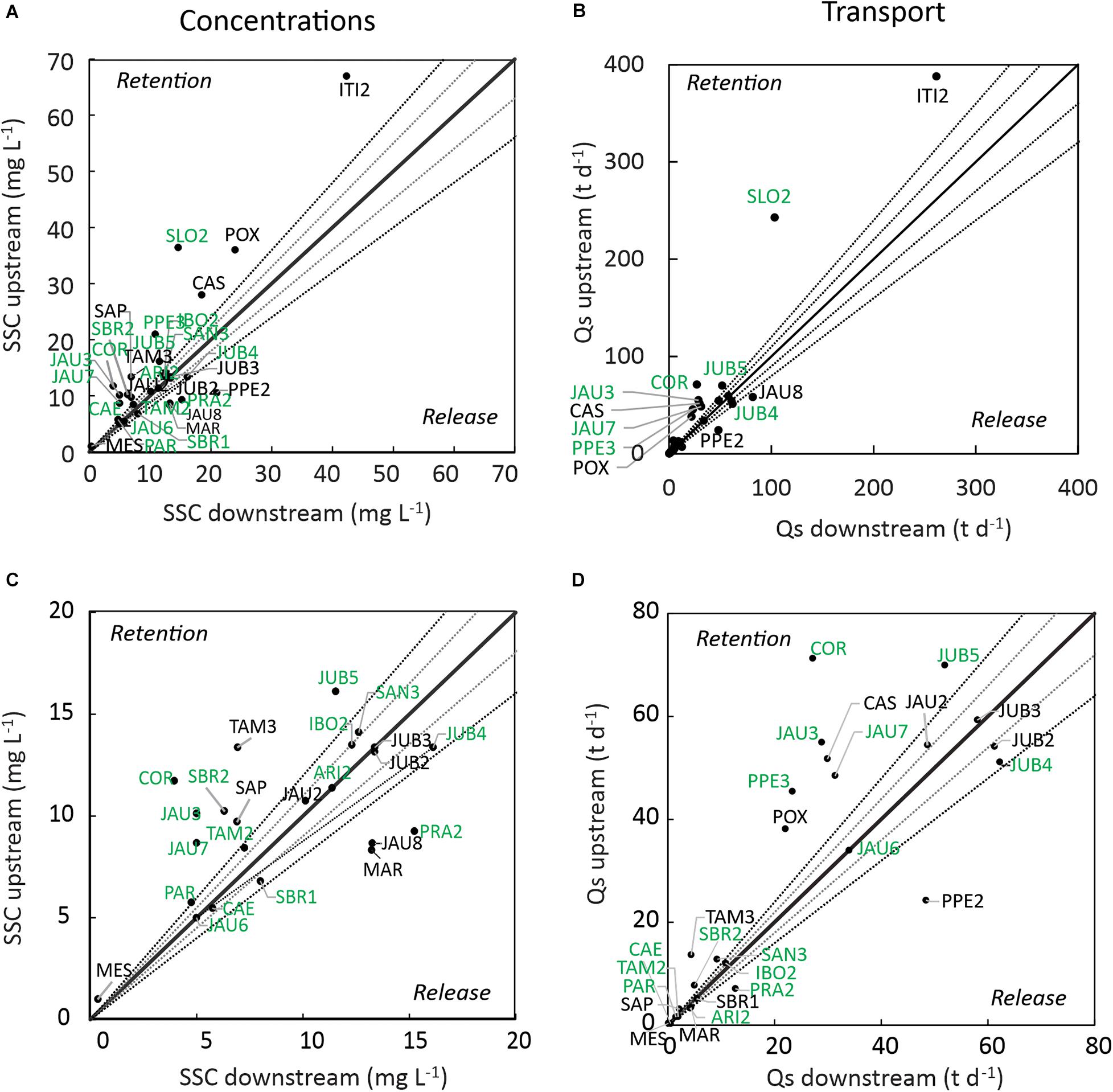
Figure 4. Comparisons of changes in water-column concentrations (SSC) and transport (Qs) of suspended sediments between upstream and downstream of current hydroelectric facilities based mainly on primary data collected in this study as well as some secondary data. (A,B) All data on concentrations and transport, respectively; (C,D) the same data with high values excluded. Solid line shows the line of parity and dashed lines show bounds of ±10 and ±20% around that line; points above the line indicate net retention and those below indicate net release between the upstream and downstream sampling points. Upstream:downstream ratios that deviate considerably from 1:1 are identified with the codes shown in Table 1; codes in green font indicate cases where the statistical analysis of the changes across all individual sampling dates showed significant (p < 0.05) differences from zero.
Fourteen of the 29 current hydropower facilities showed upstream:downstream SSC ratios >20% above the 1:1 line, indicating net retention of suspended sediments (Figure 4). Two others fell between 10 and 20% retention, seven were within 10%, and six showed >10% release. Two of the reaches with the highest SSCs and transport—ITI2 on the Itiquira River and SLO2 on the São Lourenço River—also showed large absolute values of net retention. That is not the case for the next three reaches with relatively high SSCs (POX, CAS, and PPE3), which also retained a large fraction of the suspended sediment input but had much lower rates of transport. Summing all of the riverine transport rates for above and below the 29 facilities studied here shows a total net retention of suspended sediments of 140 kt y–1 (i.e., from 518 to 378 kt y–1).
The nearly complete retention of sediments by the large reservoir on the Manso River can be added to the above estimate. Comparison of the SSC-discharge relationships for the Cuiabá River before and after construction shows that damming the Manso River reduced suspended sediment transport downstream in the Cuiabá River at the city of Cuiabá by ∼60% (Supplementary Figure S3). The total retention by all dams in the upland watershed draining to the Pantanal is thus estimated to be 865 kt y–1, amounting to a 32% reduction in aggregate sediment transport by current hydropower facilities (Figure 5).
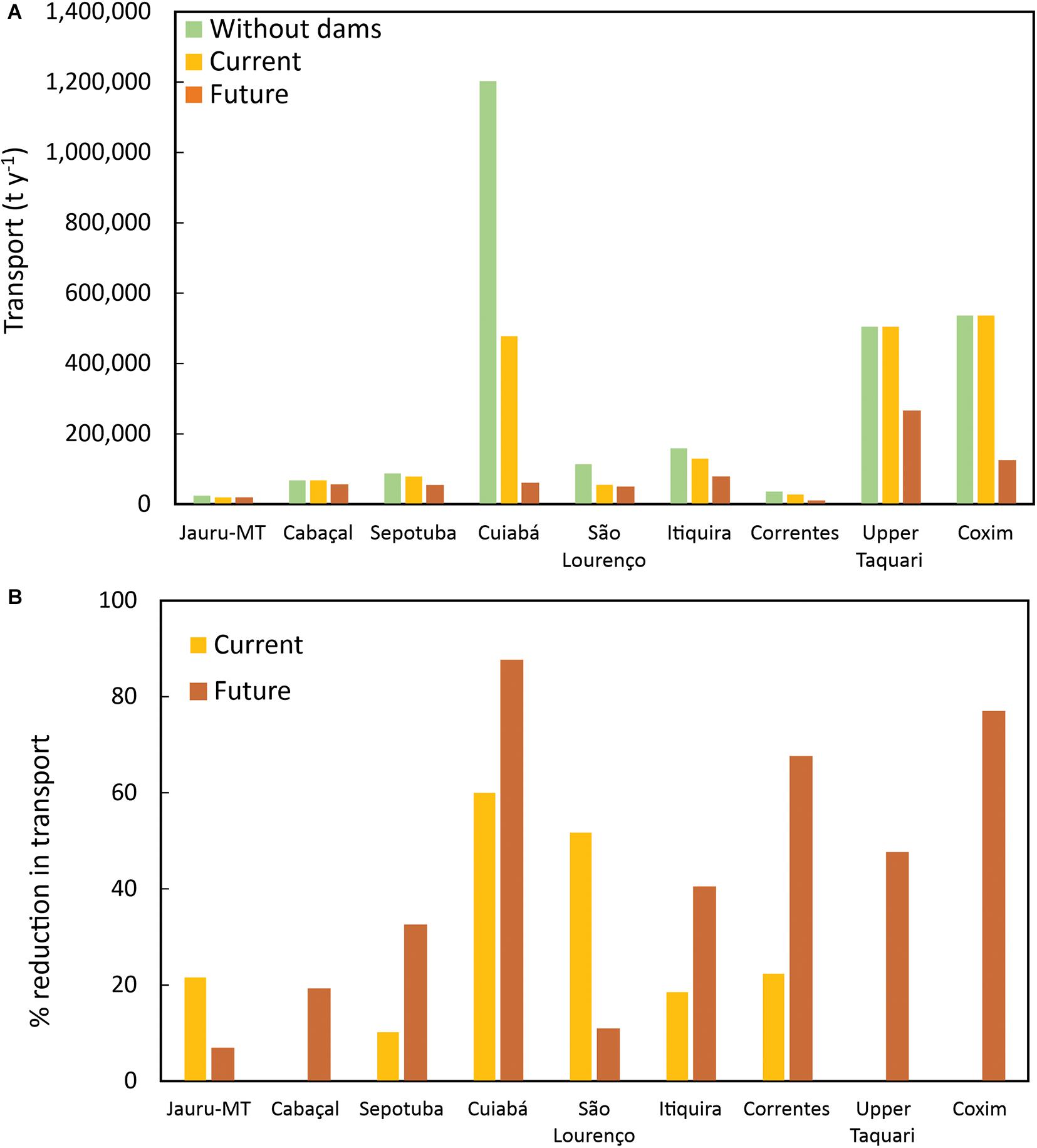
Figure 5. Impacts of damming on total sediment transport to the Pantanal. (A) Annual suspended sediment transport to the Pantanal at present with and without current dams, as well as rates predicted by the neural network modeling were all future hydropower facilities to be built in each river system; (B) percent change between current rates and predicted future rates.
Net sediment retention by individual hydropower facilities (not including Manso) was best predicted by the upstream SSC concentration and the water residence time in the reservoir, which together explained 54% of the variation using a regression tree (Supplementary Figure S4). Facilities where the upstream SSC exceeded 18 mg L–1 showed a mean SSC retention of 59%. Residence time was a significant predictor for reaches with SSC < 18 mg L–1, with net retention (mean, 31%) only when the residence time exceeded 1.8 days.
A similar upstream:downstream comparison for the 16 sites that have bedload sediment transport measurements shows that two reaches with the largest absolute rates of bedload sediment transport–SLO2 and ITI2–showed large deviations from the 1:1 line, but in opposite directions (Figure 6). The SLO2 reach retained virtually all of its bedload, whereas the ITI2 reach showed net release (the Itiquira reservoir was largely infilled with sediment). Among the reaches with much lower rates of bedload sediment transport, most showed net retention of most of the bedload, although JAU2 on the Jauru River in Mato Grosso (Jauru-MT) showed net release (Figure 6B). Several reaches showed bedload retention rates that were so small that any net changes may be inconsequential to downstream ecosystems. Summing all of the riverine transport rates for above and below the 17 facilities with measurements of bedload shows a total net retention of bedload sediments of 2.01 kt y–1 (i.e., from 8.64 to 6.64 kt y–1). Actual total retention is considerably larger because bedload was only measured on a subset of the reaches with hydropower facilities.
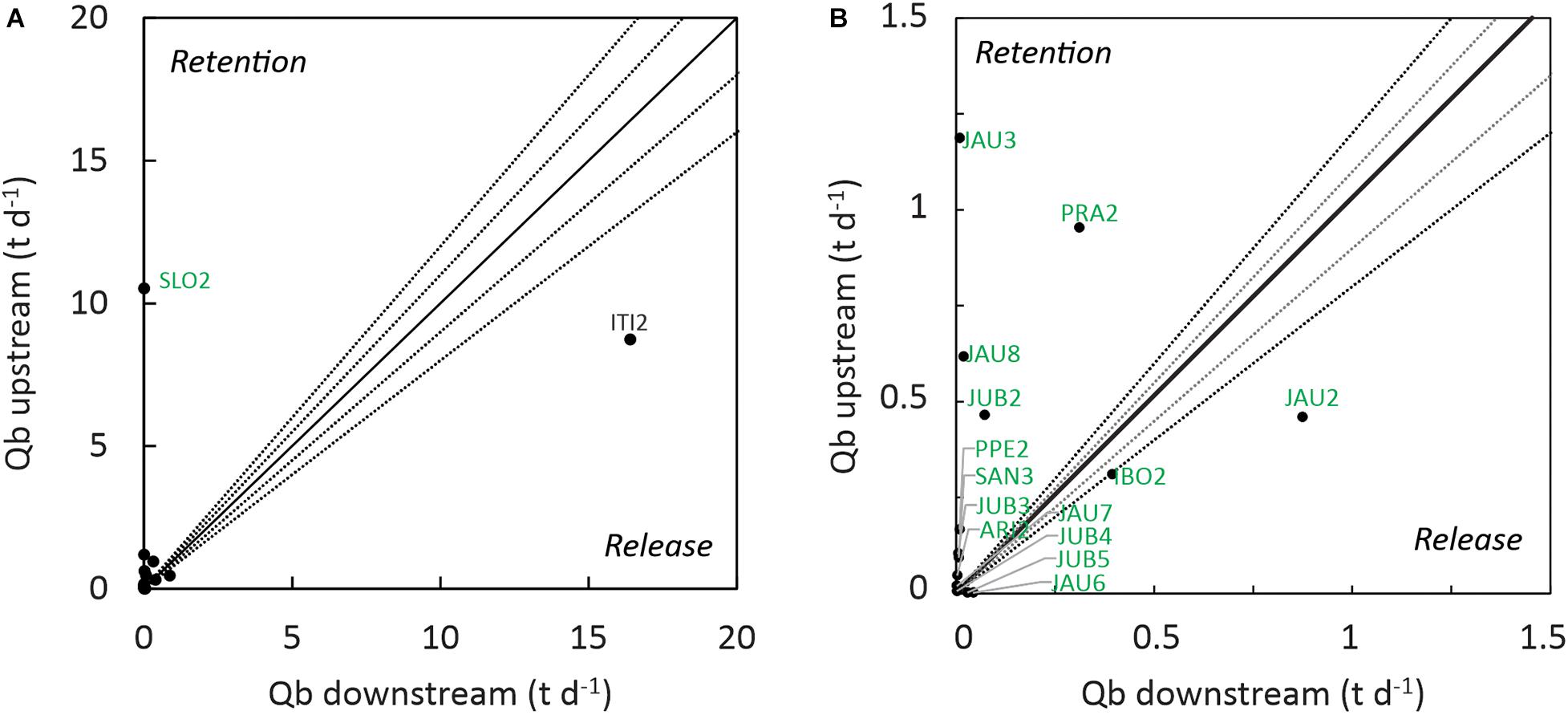
Figure 6. Comparisons of changes in bedload sediment transport between upstream and downstream of current hydroelectric facilities based on primary data collected in this study. (A) All data; (B) the same data with high values excluded. Solid line shows the line of parity and dashed lines show bounds of ±10 and ±20% around that line; points above the line indicate net retention and those below indicate net release between the upstream and downstream sampling points. Upstream:downstream ratios that deviate considerably from 1:1 are identified with the codes shown in Table 1; codes in green font indicate cases where the statistical analysis of the changes across all individual sampling dates showed significant (p < 0.05) differences from zero.
Dividing sediment transport rates for rivers at their points of entry into the Pantanal by watershed areas gives specific sediment yields, which range from 3.38 to 45.5 t km–2 y–1. These are compared against potential sediment production estimated by Mingoti et al. (2020) using the SWAT model in Figure 7 and Supplementary Table S5. The ratio of transport to potential production, known as the sediment delivery ratio, ranged from 0.0015 to 0.0098 with the highest ratios in the Cuiabá (0.0098), upper Taquari (0.0092), and Coxim (0.0081) rivers. The sum of sediment transport by upland rivers into the Pantanal was 1.91 Mt y–1, or 23 t km–2 y–1, and the overall sediment delivery ratio was 0.0074.
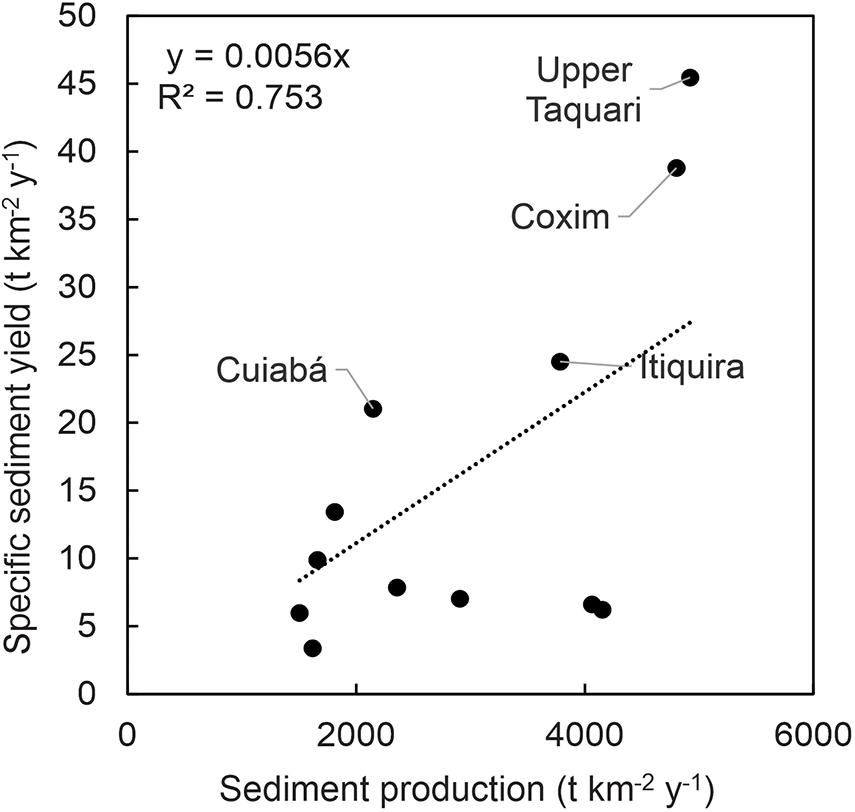
Figure 7. Comparison of specific sediment yields measured in rivers near their points of entry into the Pantanal to potential sediment production in their watersheds as estimated using the SWAT model (Mingoti et al., 2020).
Among the potential input variables that were considered for the ANNs, the most significant predictor of sediment retention was the measured upstream SSC concentration, accounting for nearly half of the predictive capability of the model (Supplementary Figure S5). Also important were soil and land use classes (n = 11 and 10 classes, respectively) and watershed sediment yields from the SWAT model, together accounting for about 33% of the predictive capability. The contributing watershed area and reservoir area and volume were also significant, though less important, predictors of SSC. The performance of the ANNs was satisfactory as indicated by the Nash-Sutcliffe model efficiency coefficients, which were 0.889 for training and 0.826 for verification.
Model predictions of the impacts of future hydropower facilities on SSCs and transport show retention of a large fraction (often much >20%) of sediment inputs at most of the reaches across the range of concentrations and transport (Figure 8). The measured current and modeled future rates of suspended sediment transport by the major rivers flowing from the upland watershed into the Pantanal, based on the most downstream sampling points, are summarized in Figure 5.
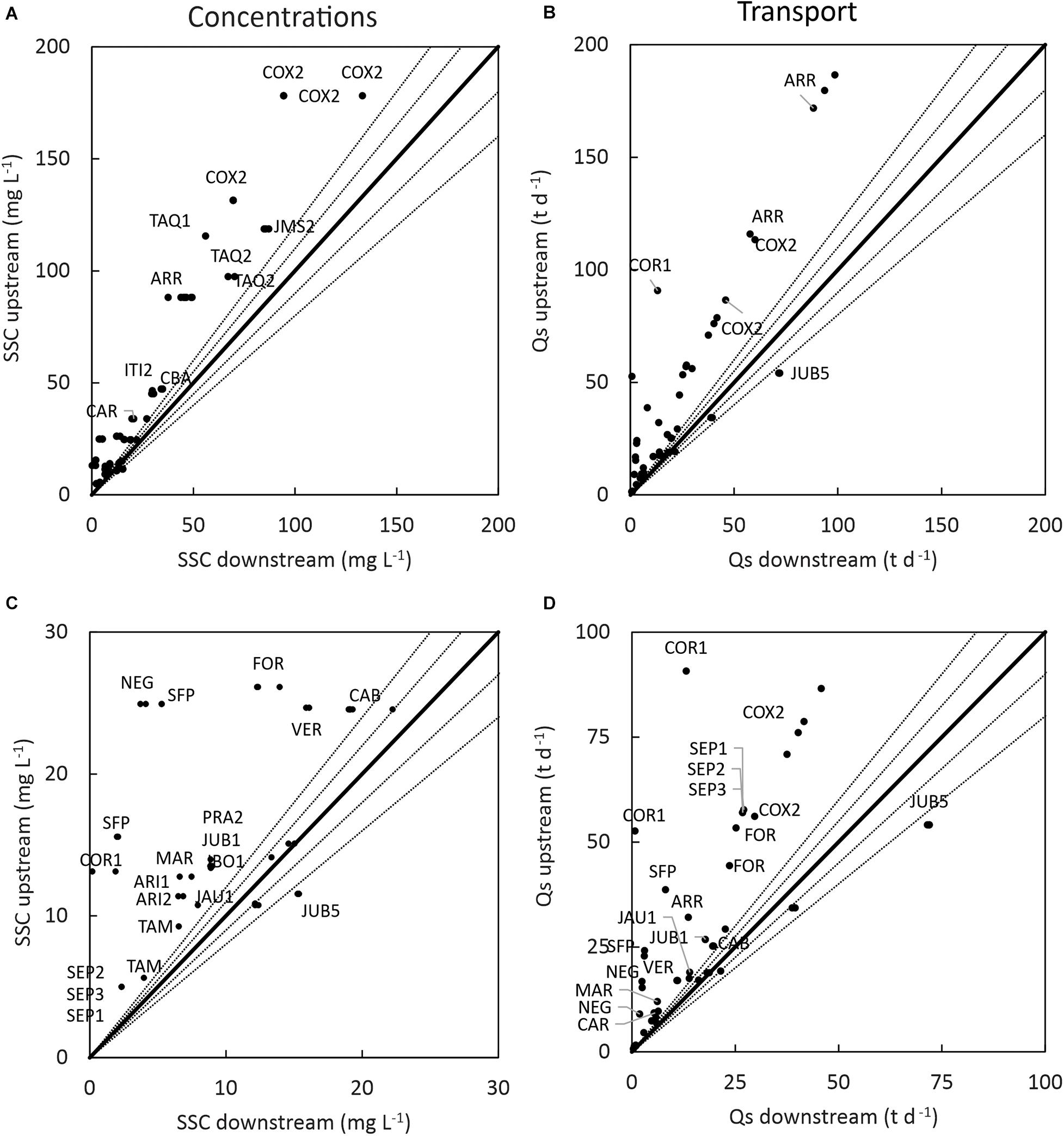
Figure 8. Comparisons of neural network model predictions of changes in suspended sediment concentrations (SSC) and transport (Qs) between upstream and downstream of future hydroelectric facilities, with river systems labeled by codes in Table 1. (A,B) All data on concentrations and transport, respectively; (C,D) the same data with high values excluded. Solid line shows the line of parity and dashed lines show bounds of ±10 and ±20% around that line; points above the line indicate net retention and those below indicate net release between the upstream and downstream sampling points. Upstream:downstream ratios that deviate considerably from 1:1 are identified with the codes shown in Table 1.
Very large decreases in sediment transport are predicted for the three river systems with the largest contributions of sediments to the Pantanal—the Cuiabá, upper Taquari, and Coxim rivers. A number of rivers with lower rates of sediment transport are still predicted to show significant percent reductions if future SHPs are built (Figure 5B). Available data for a few smaller rivers with relatively low rates of transport are not shown (Negro-MS, Aricá Mirim, and Ribeirão Ponte de Pedra rivers), and the Taquari River is divided into its two major tributaries (upper Taquari and Coxim rivers) whose confluence is a short distance upstream of the border of the Pantanal. Summing all of the riverine transport rates for inflows into the Pantanal indicates that future hydropower development would result in reductions of 62% of the suspended sediment transport from the uplands to the Pantanal (i.e., from 1.93 to 0.73 Mt y–1).
Two examples of reservoirs with readily visible sediment accumulation over time are shown in Figure 9. The São Lourenço dam created a long, relatively narrow reservoir, and the visible sediment infilling has occurred in its uppermost reach, effectively forming a delta in which shallow or periodically flooded areas have become colonized by floating and emergent wetland vegetation. The Itiquira dam created a wide reservoir along a short reach and has filled in considerably in spite of persistent efforts to recover the sand over the years, an operation that is visible at the end of the road on the southeastern edge of the reservoir.
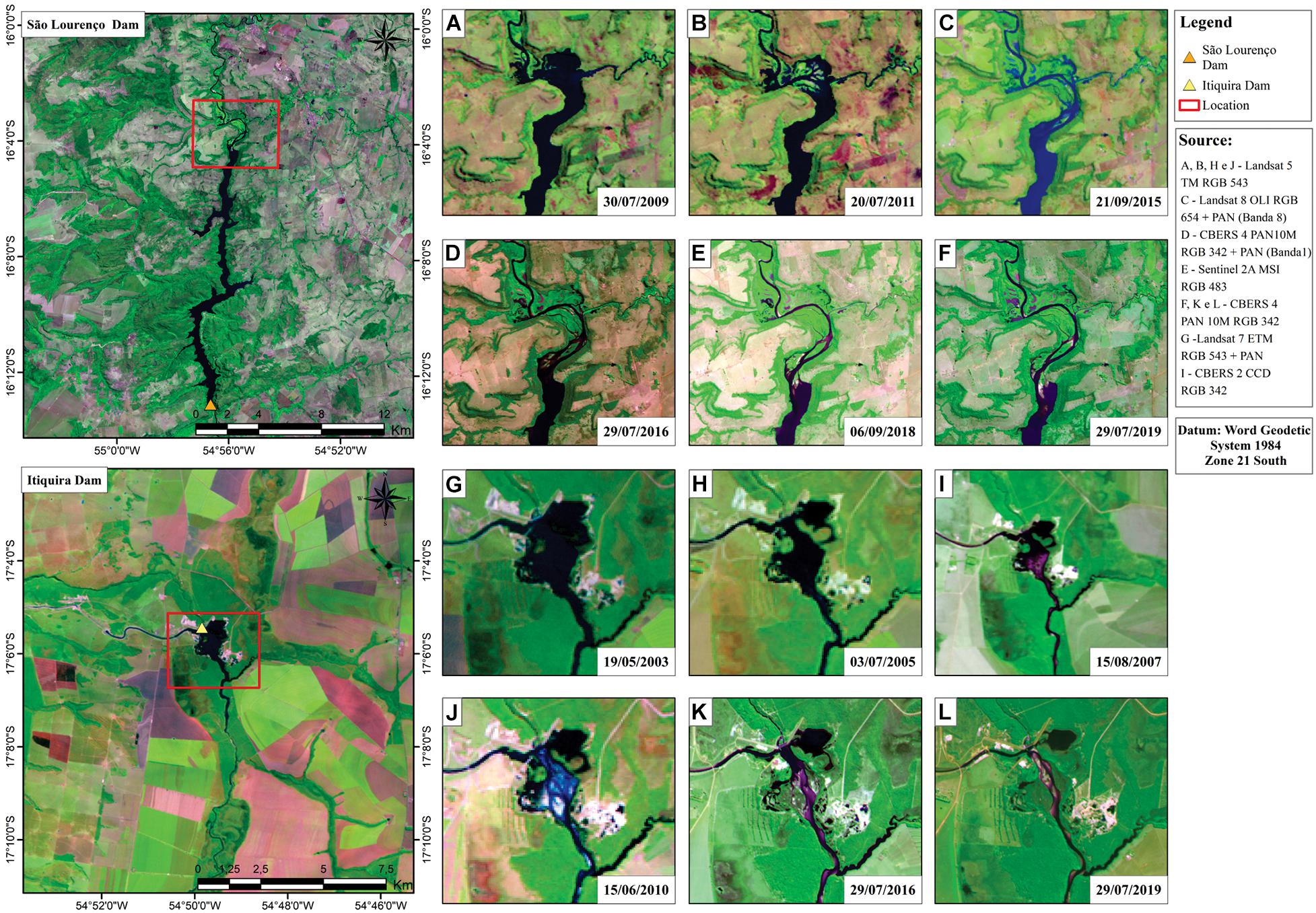
Figure 9. Satellite images showing progressive sedimentation and infilling of reservoirs created by the (A–F) Itiquira dam (completed in 2002) and (G–L) São Lourenço dam (completed in 2009).
This study presents a comprehensive analysis of SHP impacts on sediment concentrations and transport that is unprecedented in the literature and informs decisions about future hydropower development in the Upper Paraguay River basin and in similar settings elsewhere in Brazil and worldwide. In particular, our results are applicable to some of the major frontiers of SHP development that are in similar landscapes, including elsewhere in Latin America, east Africa, and Southern Asia (Couto and Olden, 2018).
This study shows that sediment retention, while well known for larger dams and reservoirs, also is characteristic of SHP facilities, and that without mitigation measures future construction of SHPs in the remaining undammed river systems with high sediment transport rates will reduce the total sediment transport from the upland watershed to the Pantanal by about 62% from the current rate. Many of the current hydropower facilities are on rivers with relatively low sediment concentrations and transport, and thus their impact on sediment transport from the uplands to the Pantanal has been modest. Nevertheless, certain tributaries with hydropower facilities are experiencing significant retention of suspended sediments, including the large effect of the dam on the Manso River, and satellite images provide evidence of long-term accumulations of sediments above some dams.
The undammed river systems with high sediment loads reflect the combination of erodible soils and agricultural land use, including livestock grazing, in their watersheds, and our results show that damming those river systems may prove problematic for sediment management. The Coxim, upper Taquari, and Cuiabá rivers are particularly vulnerable to sediment trapping by future SHPs, which will likely result in serious problems of infilling above the dams. The sediment retention would also negatively impact downstream river channels and floodplains by altering the geomorphological dynamics, potentially creating a sediment starvation situation where river channels incise, banks become destabilized, and floodplain inundation and accompanying sediment and nutrient deposition are reduced, with negative consequences for fisheries, wildlife habitat, and agriculture and human settlements in the riparian zones (Kondolf et al., 2014a; Wohl et al., 2015).
The direct measurement of sediment retention reported in our study is superior to estimation using models developed to apply to a wider variety of rivers and hydropower facilities (reviewed in Tan et al., 2019). The Churchill (1948) model is considered appropriate for small reservoirs (Morris and Fan, 1998; Carvalho, 2008). Comparison of mean trap efficiencies based on our observations of sediment retention to those estimated with the Churchill model showed divergent results, however, with the Churchill model greatly overestimating sediment trapping at 11 of 16 facilities (data not shown).
A few previous studies in the region have predicted sediment trapping in spite of a lack of direct measurements upstream and downstream of the hydropower facilities. Based on considerably less available data on sediment transport and considering locations of current and future hydropower facilities as of 2010, and assuming 100% sediment trap efficiency by dams, Souza Filho (2013) estimated the potential future reduction in sediment loading to the Pantanal to total 52%, less than the 62.4% estimated in our forecasts. However, in the case of the Taquari River system, both the discharge and SSCs and therefore the rates of transport used by Souza Filho were considerably higher than our measurements (this could reflect a real change over time).
Sediment trapping behind individual dams has been estimated using standard approaches (including empirical observations of sediment transport and estimates of trap efficiency) for some projects prior to their construction. For the Manso dam, Carvalho and Lôu (1990) estimated a >95% trap efficiency, with time to complete infilling of ∼1,000 y. For the Itiquira dam, which has a much smaller and shallower reservoir, Carvalho et al. (2000), using Churchill’s trap efficiency model, estimated a lifetime of only 8–12 years (the shorter estimate accounted for a likely increase in soil erosion over time). In fact, since its construction in 2000, the Itiquira reservoir has largely filled in with sediment, as is evident in the satellite imagery.
Although bedload is a small component of total sediment transport in rivers flowing to the Pantanal, it is particularly susceptible to retention behind dams. Over long time periods, and particularly in rivers that are presently largely undammed and carry higher bedload transport (e.g., the Taquari and Cuiabá), the accumulation of bedload can result in significant infilling above these dams. While periodic removal may alleviate infilling problems, if removal entails downstream discharge of high sediment loads there may be ecological risks that require careful consideration (Kondolf et al., 2014a).
Decisions about whether and where to construct dams in the Upper Paraguay River basin should consider not only sediment transport but also other environmental and social impacts. Two other kinds of impacts that are particularly important are nutrient transport (Oliveira et al., in press) and river system connectivity for migratory fish (Campos et al., 2020).
Based on these results as well as our parallel study on nutrient transport (Oliveira et al., in press) and a recent analysis of migratory fish routes in the region (Campos et al., 2020), development of new SHPs on the remaining undammed tributaries to the Pantanal may present serious risks to downstream river and floodplain ecosystems. Although the numerous dams in the northern part of the watershed have only modestly reduced sediment and nutrient transport because many are on rivers with low rates of transport, our modeling indicates that future construction of dams on rivers with higher sediment loads is likely to substantially reduce sediment transport from the uplands to the Pantanal. Substantial reductions in river sediment transport will likely lead to geomorphic changes that harm river and floodplain ecosystems and compromise the services they provide to people. Retention of sediments also reduces nutrient transport because particulate forms comprise major fractions of total nitrogen and phosphorus transport. Oliveira et al. (in press) showed that the new dams could reduce total phosphorus transport to the Pantanal by 29% from the current rate, with retention mainly by sediment trapping.
Considering potential reductions in transport of sediments as well as nutrients (Oliveira et al., in press), we recommend that new hydropower facilities should not be built on undammed rivers entering the Pantanal that have particularly low sediment and nutrient concentrations and transport, as well as on those that have the highest absolute rates of sediment and nutrient transport to the Pantanal.
Much of the nutrient load of these rivers is in particulate form and is thus associated with suspended sediments (Oliveira et al., in press). River systems with low nutrient concentrations are likely to be most sensitive to reductions in nutrient availability. In response to trapping of sediments and associated nutrients by damming, these rivers and their floodplains likely would experience oligotrophication, with negative consequences for fisheries yields and overall river and floodplain ecosystem productivity, as has been observed with dammed rivers elsewhere (Stockner et al., 2000). This dam-induced oligotrophication may eventually affect the fertility of pastures used for cattle (Forsberg et al., 2017). In the Upper Paraguay River basin, particularly low nutrient concentrations occur mainly in the Sepotuba, Correntes, and São Lourenço river systems, though the latter is already dammed in its lower reach.
River systems that carry the largest quantities of sediments to the Pantanal also deserve protection because their high sediment loads affect river channels and floodplains not only within the Pantanal but also downstream along the Paraguay River beyond the Pantanal (Oliveira et al., 2019). River systems of particular importance to the sediment and nutrient budget of the Pantanal that remain undammed, at least in their lower reaches, include the Cuiabá and Taquari (including its tributary the Coxim River).
This study, together with one on nutrient transport (Oliveira et al., in press), presents a comprehensive analysis of SHP impacts that is unprecedented in the literature and informs decisions about future hydropower development in the Upper Paraguay River basin and in similar settings elsewhere in Brazil and worldwide. Current facilities retain suspended and bedload sediment, and model predictions for hydropower facilities that may be built in the future on rivers flowing into the Pantanal point to large reductions in sediment transport, with potential negative consequences for downstream river and floodplain productivity. Negative impacts may be either because the rivers carry low sediment and nutrient concentrations, thereby being sensitive to oligotrophication, or are particularly important overall sediment and nutrient sources to the Pantanal, thereby supporting ecosystem productivity in downstream rivers and floodplains including particularly the Paraguay River axis within the Pantanal. Considering current and potential future effects on both sediment and nutrient transport, we recommend no additional hydropower development on the Cabaçal, Sepotuba, Cuiabá, and Taquari/Coxim rivers. Maintenance of the natural transport of sediments and nutrients from the uplands to downstream rivers and floodplains, as well as the connectivity between the floodplains and upland rivers for migratory fishes, would protect the productivity and biodiversity of the Pantanal.
The raw data supporting the conclusions of this article will be made available by the authors, without undue reservation.
IF-C, MO, MS, and SH conceived and carried out the study. IF-C, MO, LS, and MC conducted the field work and data analysis. JC, OP, and RM developed the modeling. IF-C, MO, and SH wrote the manuscript. All authors contributed to the article and approved the submitted version.
The authors declare that the research was conducted in the absence of any commercial or financial relationships that could be construed as a potential conflict of interest.
Funding was provided by the Brazilian National Water Agency and the Eliseu Alves Foundation (Case 062/ANA/2016), the Foundation for Research Support in the State of Mato Grosso (FAPEMAT Case 0249639/2017), the Brazilian National Council for Scientific and Technological Development (CNPq, Case 435543/2018-0), and the Critical Ecosystem Partnership Fund (Grant Agreement CEPF-104254). Financial, logistical, and technical support was provided by the Brazilian Corporation for Agricultural Research (EMBRAPA), and the Federal University of Mato Grosso (PROPeq/PROAD-UFMT).
We are grateful for support in field activities and access to secondary data provided by the State Secretariats for the Environment of Mato Grosso (SEMA-MT) and Mato Grosso do Sul (IMASUL), the Prosecutor’s Office of the State of Mato Grosso (MP-MT), the Brazilian Association for Clean Energy generation (ABRAGEL) and the Union of Construction, Generation, Transmission, and Distribution of Electrical Energy and Gas in the State of Mato Grosso (SINDENERGIA). We also appreciate field assistance by Valdeci Oliveira, Josias Campos, Hernandes Monteiro, Valdomiro Lima e Silva, Adriano Dias, and Luiz Amaro.
The Supplementary Material for this article can be found online at: https://www.frontiersin.org/articles/10.3389/fenvs.2020.577748/full#supplementary-material
Agência Nacional de Águas [ANA] (2012). Orientações Para Operação de Estações Hidrométricas. Brasília: Agência Nacional de Águas [ANA].
Agência Nacional de Águas [ANA] (2018). Plano de Recursos Hídricos da Região Hidrográfica do Paraguai - PRH Paraguai. Relatório final. Brasília: Agência Nacional de Águas [ANA].
Agência Nacional de Águas [ANA] (2020). Sistema Nacional de Informações Sobre Recursos Hídricos. Brasília: Agência Nacional de Águas [ANA].
American Society of Civil Engineers [ASCE] (2000). Artificial neural networks in hydrology. I: preliminary concepts. J. Hydrol. Engin. 5, 115–123. doi: 10.1061/(asce)1084-0699(2000)5:2(115)
Arnold, J. G., Kiniry, J. R., Srinivasan, R., Williams, J. R., Haney, E. B., and Neitsch, S. L. (2012). Soil and Water Assessment Tool Input/Output File Documentation Version 2012. Available online at: http://swat.tamu.edu/media/69296/SWAT-IO-Documentation-2012.pdf (accessed November 3, 2020).
Athayde, S., Duarte, C. G., Gallardo, A. L., Moretto, E. M., Sangoi, L. A., Dibo, A. P. A., et al. (2019). Improving policies and instruments to address cumulative impacts of small hydropower in the Amazon. Energy Policy 132, 265–271. doi: 10.1016/j.enpol.2019.05.003
Barbedo, A. G. A. (2003). Estudo Hidrossedimentológico na BACIA do Alto Paraguai - Pantanal. Masters thesis, Federal University of Mato Grosso do Sul, Campo Grande.
Campos, M. M., Tritico, H. M., Girard, P., Zeilhofer, P., Hamilton, S. K., and Fantin-Cruz, I. (2020). Predicted impacts of proposed hydroelectric facilities on fish migration routes upstream from the Pantanal Wetland (Brazil). River Res. Appl. 36, 452–464. doi: 10.1002/rra.3588
Carvalho, N. O., Guilhon, L. G. F., and Trindade, P. A. (2000). “The sedimentation of a small reservoir Itiquira, a case study,” in New Trends in Water and Environmental Engineering for Safety and Life, eds U. Maione, B. Majone-Lehto, and R. Monti (Boca Raton, FL: CRC Press), 1–11. doi: 10.1201/b17397-2
Carvalho, N. O., and Lôu, W. C. (1990). “Evaluation of the useful life of a reservoir on the river manso, Mato Grosso State, Brazil: a case study,” in Proceedings of the Beijing Symposium, October 1990, Hydrological Basis for Water Resources Management, Wallingford. doi: 10.15560/1.1.1
Churchill, M. A. (1948). “Discussion of analysis and use of reservoir sedimentation data,” in Proceedings of the Federal Interagency Sedimentation Conference, ed. L. C. Gottschalk (Denver, CO: US Geological Survey), 139–140.
Collischonn, W., Paz, A. P., Melo, M. M., Medeiros, and Jardim, P. F. (2019). Potenciais Impactos de Barragens Sobre o Regime Hidrológico nos Rios da Região Hidrográfica do Paraguai. Elaboração de Estudos de Avaliação dos Efeitos da Implantação de Empreendimentos Hidrelétricos na Região Hidrográfica do Rio Paraguai. Agência Nacional de Águas. Available at; https://www.ana.gov.br/gestao-da-agua/planejamento-dos-recursos-hidricos/plano-de-recursos-hidricos-rio-paraguai/grupo-de-acompanhamento/19a-reuniao-do-gap-1/relatorio-de-andamento_hidrologia_parte1-1.pdf (accessed November 3, 2020).
Couto, T. B. A., and Olden, J. (2018). Global proliferation of small hydropower plants - science and policy. Front. Ecol. Environ. 16, 91–100. doi: 10.1002/fee.1746
Csiki, S., and Rhoads, B. L. (2010). Hydraulic and geomorphological effects of run-of-river dams. Prog. Phys. Geogr. 34, 175–206. doi: 10.1177/0309133310369435
Dawson, C. W., Abrahart, R. J., Shamseldin, A. Y., and Wilby, R. L. (2006). Flood estimation at ungauged sites using artificial neural networks. J. Hydrol. 319, 391–409. doi: 10.1016/j.jhydrol.2005.07.032
Empresa Brasileira de Pesquisa Agropecuária [EMBRAPA] (2015). Monitoramento das Alterações da Cobertura Vegetal e uso do Solo na Bacia do Alto Paraguai - Porção Brasileira (Analysis Period: 2012 to 2014). Brasilia: EMBRAPA.
Empresa Brasileira de Pesquisa Agropecuária [EMBRAPA] (2018). Brazilian Soil Classification System. Brasilia: EMBRAPA.
Empresa de Pesquisa Agropecuária e Extensão Rural de Santa Catarina [EPAGRI] (2013). HidroSedimentos: um Programa para Cálculo de Tempo de Amostragem de Sedimentos em Suspensão a Partir da Medição de Vazão com Equipamentos Acústicos Doppler: Versão 2.0, Desenvolvimento José Back. Brasília: ANA.
Fantin-Cruz, I., Pedrollo, O., Castro, N. M. R., Girard, P., Zeilhofer, P., and Hamilton, S. K. (2011). Historical reconstruction of floodplain inundation in the Pantanal (Brazil) using neural networks. J. Hydrol. 399, 376–384. doi: 10.1016/j.jhydrol.2011.01.014
Figueiredo, J. S. M. C., Fantin- Cruz, I., Silva, G. M. S., Beregula, R. L., Girard, P., Zeilhofer, P., et al. (In review). Hydropeaking by small hydropower facilities affects flow regimes on tributaries to the Pantanal Wetland of Brazil. Front. Environ. Sci.
Forsberg, B. R., Melack, J. M., Dunne, T., Barthem, R. B., Goulding, M., Paiva, R. C. D., et al. (2017). The potential impact of new Andean dams on Amazon fluvial ecosystems. PLoS One 12:e0182254. doi: 10.1371/journal.pone.0182254
Hamilton, S. K. (2002). “Hydrological controls of ecological structure and function in the Pantanal wetland (Brazil),” in The Ecohydrology of South American Rivers and Wetlands, ed. M. McClain (Wallingford: International Association of Hydrological Sciences), 133–158.
Hamilton, S. K., Sippel, S. J., and Melack, J. M. (1996). Inundation patterns in the Pantanal Wetland of South America determined from passive microwave remote sensing. Arch. Hydrobiol. 137, 1–23.
Hecht-Nielsen, R. (1989). “Theory of the backpropagation neural network,” in Proceedings of the International 1989 Joint Conference on Neural Networks, Washington, DC.
Jongman, R. H. G. (ed.) (2005). Pantanal-Taquari: Tools for decision making in Integrated Water Management. ALTERRA Special Publication 2005/02, Partners for Water Project 02-045. Wageningen: Wageningen University & Research.
Junk, W. J., da Silva, C. J., da Cunha, C. N., and Wantzen, K. M. (2011). The Pantanal: Ecology, Biodiversity and Sustainable Management of a Large Neotropical Seasonal Wetland. Moscow: Pensoft.
Kaunda, C. S., Kimambo, C. Z., and Nielsen, T. K. (2012). Hydropower in the context of sustainable energy supply: a review of technologies and challenges. ISRN Renew. Energy 2012:730631. doi: 10.5402/2012/730631
Kibler, K. M., and Tullos, D. D. (2013). Cumulative biophysical impact of small and large hydropower development in Nu River, China. Water Resour. Res. 49, 3104–3118. doi: 10.1002/wrcr.20243
Kondolf, G. M., Gao, Y., Annandale, G. W., Morris, G. L., Jiang, E., Zhang, J., et al. (2014a). Sustainable sediment management in reservoirs and regulated rivers: experiences from five continents. Earth Future 2, 256–280. doi: 10.1002/2013EF000184
Kondolf, G. M., Rubin, Z. K., and Minear, J. T. (2014b). Dams on the mekong: cumulative sediment starvation. Water Resour. Res. 50, 5158–5169. doi: 10.1002/2013WR014651
Mbaka, J. G., and Mwaniki, M. W. (2015). A global review of the downstream effects of small impoundments on stream habitat conditions and macroinvertebrates. Environ. Rev. 23, 257–262. doi: 10.1139/er-2014-0080
Mingoti, R., Sais, I. C. R., Padovani, S. R., Calheiros, D. F., and Oliveira, M. D. (2020). SWAT Model Details and Results. Available online at: http://geoinfo.cnpm.embrapa.br/layers/geonode%3Abap_bd2_v4o2_wgs84 (accessed November 3, 2020).
Morris, G. L., and Fan, J. (1998). Reservoir Sedimentation Handbook: Design and Management of Dams, Reservoirs, and Watersheds for Sustainable Use. New York, NY: McGraw-Hill.
Neitsch, S. L., Arnold, J. G., Kiniry, J. R., and Williams, J. R. (2011). Soil and Water Assessment Tool Theoretical Documentation: Version 2009. USDA-ARS, Grassland, Soil and Water Research Laboratory. Texas Water Resources Institute Technical Report:406. College Station, TX: Texas A&M University System.
Oliveira, M. D., Fantin-Cruz, I., Campos, J. A., Campos, M. M., Mingoti, R., Souza, M. L., et al. (in press). Further development of small hydropower facilities can alter nutrient transport to the Pantanal Wetland of Brazil. Front. Environ. Sci.
Oliveira, M. D., Hamilton, S. K., and Calheiros, D. F. (2019). Mass balances of dissolved solutes, nutrients, and suspended sediment as water moves through the Pantanal wetland to its outflow (Paraguay River). Braz. J. Wat. Res. 24, 1–15. doi: 10.1590/2318-0331.231820170169
Richter, B. D., Davis, M., Apse, C., and Konrad, C. (2012). A presumptive standard for environmental flow protection. River Res. Appl. 28, 1312–1332. doi: 10.1002/rra.1511
Rumelhart, D. E., Hinton, G. E., and Williams, R. J. (1986). Learning representations by backpropagating errors. Nature 323, 533–536. doi: 10.1038/323533a0
Souza Filho, E. E. (2013). As barragens na bacia do Rio Paraguai e a possível influência sobre a descarga fluvial e o transporte de sedimentos. Boletim Geograf. 31, 117–133. doi: 10.4025/bolgeogr.v31i1.13638
Stockner, J. G., Rydin, E., and Hyenstrand, P. (2000). Cultural oligotrophication: causes and consequences for fisheries resources. Fisheries 25, 7–14. doi: 10.1577/1548-8446(2000)025<0007:co>2.0.co;2
Syvitski, J. P. M., Vorosmarty, C. J., Kettner, A. J., and Green, P. (2005). Impact of humans on the lfux of terrestrial sediment to the global coastal ocean. Science 308, 376–380. doi: 10.1126/science.1109454
Tan, G., Chen, P., Deng, J., Xu, Q., Tang, R., Feng, Z., et al. (2019). Review and improvement of conventional models for reservoir sediment trapping efficiency. Heliyon 5:e02458. doi: 10.1016/j.heliyon.2019.e02458
Tomás, W. M., de Oliveira Roque, F., Morato, R. G., Medici, P. E., Chiaravalloti, R. M., Tortato, F. R., et al. (2019). Sustainability agenda for the Pantanal Wetland: perspectives on a collaborative interface for science, policy, and decision-making. Trop. Conserv. Sci. 12, 1–30. doi: 10.1177/1940082919872634
Vogl, T. P., Mangis, J. K., Rigler, A. K., Zink, W. T., and Alkon, D. L. (1988). Accelerating the convergence of the back-propagation method. Biol. Cybernet. 59, 257–263. doi: 10.1007/BF00332914
Wohl, E., Bledsoe, B. P., Jacobson, R. B., Poff, N. L., Rathburn, S. L., Walters, D. M., et al. (2015). The natural sediment regime in rivers: broadening the foundation for ecosystem management. Bioscience 65, 358–371. doi: 10.1093/biosci/biv002
Keywords: hydroelectricity, dams, tropical, sediments, bedload
Citation: Fantin-Cruz I, de Oliveira MD, Campos JA, de Campos MM, de Souza Ribeiro L, Mingoti R, de Souza ML, Pedrollo O and Hamilton SK (2020) Further Development of Small Hydropower Facilities Will Significantly Reduce Sediment Transport to the Pantanal Wetland of Brazil. Front. Environ. Sci. 8:577748. doi: 10.3389/fenvs.2020.577748
Received: 29 June 2020; Accepted: 20 October 2020;
Published: 16 November 2020.
Edited by:
Lee Baumgartner, Charles Sturt University, AustraliaReviewed by:
Joris Eekhout, Spanish National Research Council, SpainCopyright © 2020 Fantin-Cruz, de Oliveira, Campos, de Campos, de Souza Ribeiro, Mingoti, de Souza, Pedrollo and Hamilton. This is an open-access article distributed under the terms of the Creative Commons Attribution License (CC BY). The use, distribution or reproduction in other forums is permitted, provided the original author(s) and the copyright owner(s) are credited and that the original publication in this journal is cited, in accordance with accepted academic practice. No use, distribution or reproduction is permitted which does not comply with these terms.
*Correspondence: Ibraim Fantin-Cruz, aWJyYWltZmFudGluQGdtYWlsLmNvbQ==; Stephen K. Hamilton, aGFtaWx0b25Aa2JzLm1zdS5lZHU=
Disclaimer: All claims expressed in this article are solely those of the authors and do not necessarily represent those of their affiliated organizations, or those of the publisher, the editors and the reviewers. Any product that may be evaluated in this article or claim that may be made by its manufacturer is not guaranteed or endorsed by the publisher.
Research integrity at Frontiers

Learn more about the work of our research integrity team to safeguard the quality of each article we publish.